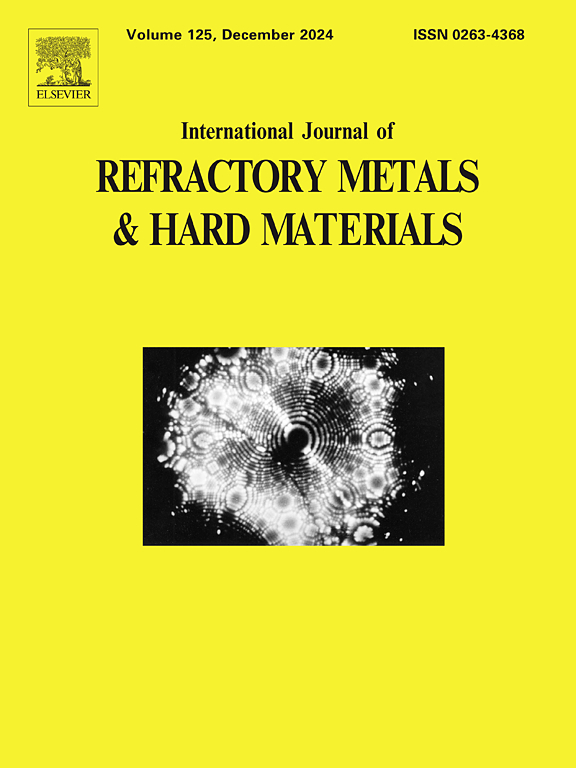Mechanical and thermal properties of Zr1-xNbxC cermet
IF 4.6
2区 材料科学
Q2 MATERIALS SCIENCE, MULTIDISCIPLINARY
International Journal of Refractory Metals & Hard Materials
Pub Date : 2025-07-21
DOI:10.1016/j.ijrmhm.2025.107341
引用次数: 0
Abstract
A new avenue of investigation to improve the properties of ZrC-based cermets is the addition of NbC into ZrC. This study explores the effects of varying the NbC content on the microstructure, mechanical properties, and thermal conductivity of Zr1-xNbxC cermet. Zr1-xNbxC cermet has a homogeneous single-phase rock-salt solid solution structure. As the concentration of NbC increases, the density and Young's modulus of Zr1-xNbxC cermet rise. The Vickers hardness and thermal conductivity of Zr1-xNbxC cermet initially increase and then decrease with the addition of NbC. The Vickers hardness and thermal conductivity of Zr0.5Nb0.5C cermet are 31.40 ± 1.13 GPa and 30.91 W/M/K at ambient temperature, respectively. The present study demonstrates the possibility of improving ZrC-based cermet by adding NbC.
Zr1-xNbxC陶瓷的力学和热性能
在ZrC中加入NbC是改善ZrC基陶瓷性能的新途径。研究了不同NbC含量对Zr1-xNbxC陶瓷显微结构、力学性能和导热性能的影响。Zr1-xNbxC陶瓷具有均匀的单相岩盐固溶结构。随着NbC浓度的增加,Zr1-xNbxC陶瓷的密度和杨氏模量增大。随着NbC的加入,Zr1-xNbxC陶瓷的维氏硬度和导热系数先升高后降低。常温下Zr0.5Nb0.5C陶瓷的维氏硬度和导热系数分别为31.40±1.13 GPa和30.91 W/M/K。本研究证明了添加NbC改善zrc基陶瓷的可能性。
本文章由计算机程序翻译,如有差异,请以英文原文为准。
求助全文
约1分钟内获得全文
求助全文
来源期刊
CiteScore
7.00
自引率
13.90%
发文量
236
审稿时长
35 days
期刊介绍:
The International Journal of Refractory Metals and Hard Materials (IJRMHM) publishes original research articles concerned with all aspects of refractory metals and hard materials. Refractory metals are defined as metals with melting points higher than 1800 °C. These are tungsten, molybdenum, chromium, tantalum, niobium, hafnium, and rhenium, as well as many compounds and alloys based thereupon. Hard materials that are included in the scope of this journal are defined as materials with hardness values higher than 1000 kg/mm2, primarily intended for applications as manufacturing tools or wear resistant components in mechanical systems. Thus they encompass carbides, nitrides and borides of metals, and related compounds. A special focus of this journal is put on the family of hardmetals, which is also known as cemented tungsten carbide, and cermets which are based on titanium carbide and carbonitrides with or without a metal binder. Ceramics and superhard materials including diamond and cubic boron nitride may also be accepted provided the subject material is presented as hard materials as defined above.

 求助内容:
求助内容: 应助结果提醒方式:
应助结果提醒方式:


